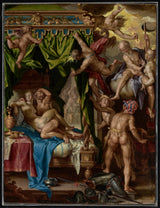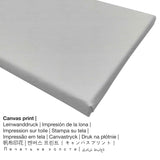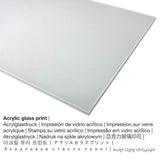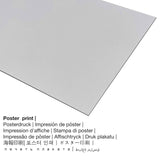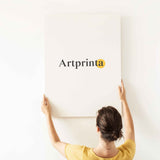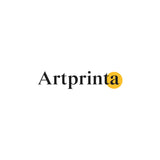Joachim Wtewael, 1608 - Mars na Venus tụrụ Vulcan n'anya - mbipụta nka mara mma.
Ụtụ gụnyere. Mbupu gbakọrọ na ndenye ọpụpụ.
Ngwa ngwaahịa dị
Anyị na-enye ihe dị iche iche dị iche iche na nha maka ngwaahịa ọ bụla. N'ihi ya, anyị na-enye gị ohere ịhọrọ n'ime nhọrọ ndị a:
- Mbipụta iko acrylic (nke nwere ezigbo mkpuchi iko): The acrylic glass print, which is often described as a plexiglass print, will turn the original artwork into amazing home décor and offers a distinct alternative to dibond or canvas art prints. Your favorite work of art is manufactured with the help of state-of-the-art UV direct printing technology. This creates the image effect of and vivid colors.
- Mpempe akwụkwọ ederede (akwa akwa akwa): Our poster print is a UV printed cotton canvas with a granular surface finish. Please note, that depending on the absolute size of the poster print we add a white margin of something between 2-6cm round about the artwork, which facilitates the framing with a custom frame.
- Kwaaji: The canvas direct print is a printed cotton canvas mounted on a wooden frame. How can I hang a canvas on the wall? The great advantage of canvas prints is that they are relatively low in weight. That means, it is easy to hang your Canvas print without any wall-mounts. Canvas prints are suited for all types of walls.
- Mbipụta aluminom (aluminium dibbond): These are metal prints on aluminium dibond with an outstanding effect of depth - for a modern look and a non-reflective surface structure. For our Aluminium Dibond option, we print your favorite artpiece on the surface of the aluminum material. The white & bright parts of the original artwork shimmer with a silk gloss but without any glare. The colors of the print are luminous and bright in the highest definition, the details appear very clear. The UV print on aluminium is the most popular entry-level product and is an extremely modern way to display fine art prints, since it draws focus on the replica of the artwork.
Disclaimer: We try everythig possible to depict our products as accurately as possible and to showcase them visually in our shop. Nonetheless, the pigments of the print products and the printing may differ to a certain extent from the image on your monitor. Depending on the settings of your screen and the nature of the surface, not all color pigments will be printed as exactly as the digital version depicted here. In view of the fact that our are printed and processed by hand, there might also be slight differences in the size and exact position of the motif.
Nkọwapụta nka nka izizi nke J. Paul Getty Museum (© - Ụlọ ihe ngosi nka nke J. Paul Getty - Ụlọ ihe ngosi nka nke J. Paul Getty)
In the Metamorphoses, the Roman author Ovid tells the story of how the lovers Venus and Mars were surprised by Venus's husband, Vulcan. Vulcan, a blacksmith, forged an invisible bronze net, which he secretly attached to Mars's bed. Here Vulcan stands upon Mars's armor, discarded at the right, while Cupid and Apollo hover above, drawing back the green canopy to reveal the astonished lovers in an embrace. Other gods and goddesses also gather to witness and mock the adulterous couple. In a scene beyond the bed, Vulcan hammers his net at the forge.
Exaggerated poses and brilliant, jewel-like color emphasize the dramatic intensity of the scene. The hard, metallic surface of the copper lends itself to highly finished and detailed pictures. Because of the erotic subject matter, the painting's early owners may have concealed the painting behind a curtain or in a drawer, which preserved its lustrous appearance.
In 1608 na Dutch painter Joachim Wtewael painted this artwork titled "Mars and Venus Surprised by Vulcan". E wezụga, artwork Nleta akụkụ nke art collection nke Ụlọ ihe ngosi nka nke J. Paul Getty located in Los Angeles, California, United States of America. We are delighted to mention that the artpiece, which is part of the ngalaba ọha is supplied with courtesy of The J. Paul Getty Museum.Also, the artpiece has the creditline: . What is more, the alignment of the digital reproduction is in Eserese format na a akụkụ ruru nke 3: 4, which means that the length is 25% shorter than the width. The painter Joachim Wtewael was a European artist, whose art style was primarily Northern Renaissance. The artist was born in 1566 ma gafee na afọ nke 72 n'afọ 1638.
Nkọwa gbasara akụkụ nka mbụ
| Aha nka: | "Mars and Venus Surprised by Vulcan" |
| nhazi ọkwa: | sere |
| Okwu mkpokọta: | nka ochie |
| Time: | 17th narị afọ |
| Emepụtara na: | 1608 |
| Afọ nka: | karịa afọ 410 |
| Ụlọ ihe ngosi nka: | Ụlọ ihe ngosi nka nke J. Paul Getty |
| Ebe ngosi nka: | Los Angeles, California, Njikota Obodo Amerika |
| website: | Ụlọ ihe ngosi nka nke J. Paul Getty |
| Licensedị ikike: | ngalaba ọha |
| Site n'aka: | Ụlọ ihe ngosi nka nke J. Paul Getty |
Nkọwapụta ngwaahịa
| Nkewa bipụta: | mmepụta nka |
| Usoro mmeputakwa: | dijitalụ mmeputakwa |
| Usoro mmepụta: | UV kpọmkwem obibi |
| Ihe ngosi: | arụpụtara na Germany |
| Stockdị ngwaahịa: | na mmepụta ihe |
| A na-atụ aro iji ngwaahịa eme ihe: | ụlọ mmepụta ihe nka, foto mgbidi |
| Ndozi onyonyo a: | nhazi ihe osise |
| Oke akụkụ: | ( Ogologo: obosara) 3: 4 |
| Pụtara nha onyonyo: | ogologo bụ 25% mkpụmkpụ karịa obosara |
| Nhọrọ ihe onwunwe: | akwụkwọ mmado (akwụkwọ kwaaji), mbipụta ọla (aluminium dibond), mbipụta kanvas, mbipụta iko acrylic (nwere ezigbo mkpuchi iko) |
| Nhọrọ nha nke akwa akwa n'elu etiti ihe na-agbatị (mbipụta kwaaji): | 30x40cm - 12x16", 60x80cm - 24x31", 90x120cm - 35x47", 120x160cm - 47x63" |
| Mpempe iko acrylic (nwere ezigbo mkpuchi iko) nha: | 30x40cm - 12x16", 60x80cm - 24x31", 90x120cm - 35x47", 120x160cm - 47x63" |
| Mpempe akwụkwọ mmado (akwụkwọ kwaaji) nha: | 30x40cm - 12x16", 60x80cm - 24x31", 90x120cm - 35x47" |
| Ụdị mbipụta Dibond (ihe alumnium) dị iche iche: | 30x40cm - 12x16", 60x80cm - 24x31", 90x120cm - 35x47" |
| Igwe onyonyo: | ngwaahịa anaghị emebi emebi |
Banyere omenka
| Aha onye nka: | Joachim Wtewael |
| okike onye nka: | nwoke |
| Nationality: | Dutch |
| Ọrụ: | onye na-ese ihe |
| Obodo onye nka: | mba netherland |
| Nhazi nke onye nka: | nna ukwu ochie |
| Ụdị nka: | Northern Renaissance |
| Afọ ọnwụ: | 72 afọ |
| Afọ ọmụmụ: | 1566 |
| Nwuru: | 1638 |
© Nwebiisinka nke | www.artprinta.com (Artprinta)

